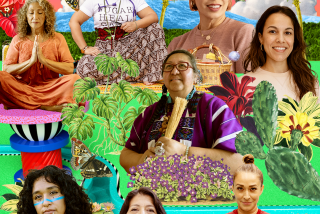Greeting the New Year With Retreats, Personal Rituals
Hosting--or attending--a New Year’s Eve party doesn’t interest Jean Bernstein of South Laguna.
Instead, at the end of each year, Bernstein prefers to take several days off from her volunteer anti-nuclear work with the Alliance for Survival and camp out with her grown children in the Anza Borrego Desert.
The location, in eastern San Diego County, is full of memories for Bernstein, 63--her long-time companion Peter Carr, a Cal State Long Beach comparative literature professor who died in 1981, loved the place too.
The desert “has a kind of spiritual resonance,” Bernstein said. Camping there “is just about the only thing we do ritually as a family that sort of physically removes us from the rest of society and connects us with something more primordial . . . with the sky, the earth, the water.”
Many Personal Rituals
Many religious groups plan year-end retreats for their members, and non-religious private parties abound. But an informal survey of Southern Californians turned up only a few individuals who, like Jean Bernstein, have devised their own rituals for welcoming the new year.
Several people--including Maurice Ogden, minister of the Anaheim-based Unitarian Church of Orange County--said that rituals are not particularly important to them.
“Personally, I’m very low on ritual activities, and lots of times I just don’t do anything on New Year’s,” Ogden said. “I tend to sort of ignore (traditional holidays), not to be caught up in them.”
Many people said they prefer to forgo dramatics (and parties) and quietly toast the New Year at home with a loved one.
For instance, Maria Marable, the Southwest Museum’s program coordinator, said that tonight she and her husband, Lonnie Bunch, curator of the California Afro-American Museum, will “just stay at home, and watch the ball go down in New York (City’s Times Square on television), toast each other and go to sleep.”
Marable, who lives in Altadena, added that she dreams of someday staging a more elaborate New Year’s Eve celebration. “I would like to try starting out in New York, and fly across the country, celebrating New Year’s each time” the clock strikes midnight in a different time zone, she said.
While creative year-end ritualists are rare, they tend to be firm believers in their rites’ importance.
Bernstein said her family’s camp-out “binds us closer. The very essence of the place serves as a nonverbal reminder of how we are connected.”
Three of Bernstein’s four children now have homes outside Southern California, but this year all but one daughter joined the desert encampment that started last Saturday.
At Anza Borrego, Bernstein said, the family always hikes up Borrego Palm Canyon to its several oases. They also visit pictographs and other reminders of the Cahuilla Indians who once lived on the site of the state park, and they sometimes rise early on New Year’s Day to see the dawn.
Being far from their usual haunts helps family members “shake off for a while all the myriad details of living in a complex society, and relate to each other in an intimate, human, loving way,” Bernstein said.
According to Amy Gross, a marriage, family and child counselor who manages the West Valley Recovery Center in Canoga Park, “there’s a tradition in every culture of seeing the dead of winter as the lowest time. . . . There’s this need for some kind of ritual that renews hope.” Even people who become extremely depressed at year’s end yearn for a way “to celebrate that there is a future, there is hope,” Gross said.
Every year Gross and her mathematician-husband, Kenneth, spend an hour or two on Dec. 31 creating a list of eight to 12 “guiding goals” for the months ahead, Gross said. They look at their list from the preceding year, compare it with their accomplishments, and set their new priorities on budgeting, vacation plans and wishes for personal accomplishment.
After finishing the list, “we go to bed at 10 (p.m.), and forget about parties,” she said.
Gross said she advises her clients, many of whom are recovering drug and alcohol addicts, to make their own New Year’s resolutions. Such lists, if they combine ambition with realism, can provide “a sense of hope for the next year,” she said.
Another who believes in the importance of year-end rituals is Deena Metzger, a Topanga Canyon writer who’s best known locally for her poetry.
At year’s end, “if you really have clarity of spirit, you can sever the past that’s inhibiting or constricting you (and) jump into the new year,” said Metzger, 50. Rituals can help create such spiritual clarity, she added.
Meditating on Peace
Metzger starts each year with a “peace meditation” during which she imagines “the planet in a peaceful state, surrounded by green.” She believes this meditation can help bring about world peace.
Metzger is spending this year-end in Guatemala. On New Year’s Eve she said she plans to practice, with her lover, an exercise called “ trespasso , a meditation for intimacy where you simply look into the other’s eyes for 20 minutes.”
Such practices “heighten and validate what’s real,” Metzger said. “They take me from the distraction and illusion of everyday life to the reality” she perceives in spiritual elements outside herself. “So, in the new year, I have the sense of a real beginning, that it really is a new year and there’s incredible possibility,” she said.
More to Read
Sign up for Essential California
The most important California stories and recommendations in your inbox every morning.
You may occasionally receive promotional content from the Los Angeles Times.









